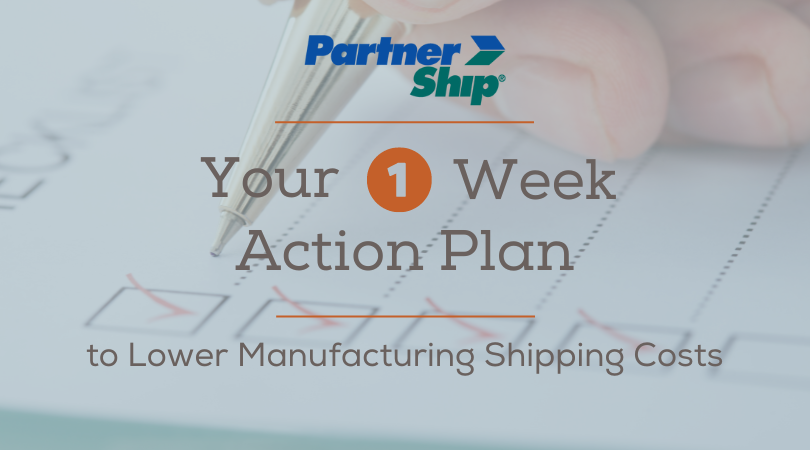Your One Week Action Plan to Lower Manufacturing Shipping Costs
03/09/2023 — Jen Deming

Right now, the manufacturing industry is tough. Our economy is unpredictable, and both labor and raw materials expenses are high. When looking for cost-saving opportunities, it’s critical that manufacturers assess areas of the business where you may have the greatest degree of control, such as shipping. With a little bit of planning, your team can tackle one cost-saving strategy a day to ensure lower freight charges within a work week.
Day 1 - Audit your top freight classes
Freight classification is an important part of LTL shipping, and it’s important to make sure the ones you are using are accurate. If they are incorrect, your freight may be reclassified and you will pay a fee, which is both expensive and disruptive.
Make sure your team is reviewing your most commonly used freight classes and checking them against current NMFTA codes. Manufacturers have an extra challenge due to the sheer volume of materials being shipped, often within one load. Product classes for items like parts, tools, or built-machinery can vary wildly, especially if they fall within a density-based category. Codes are updated regularly, so you can’t just look it up once and think you’re good to go on every shipment you move. Even small changes in weight, dimensions, or packaging type can affect your class and freight charges.

You should regularly audit your freight invoices for discrepancies between what class you’ve used to quote and what shows up on your final bill. If you see any class codes that are regularly corrected, make sure you’re adjusting that for the future. For new products, always review resources like ClassIT or speak with an experienced freight professional who can help you decode your freight class.
Day 2 - Optimize your packing strategies
The way you approach packing procedures for your freight shipments can greatly affect your shipping costs. Palletizing your loads keeps your products together and improves the structural integrity of your shipment as it travels through the LTL network. Being intentional in your packing choices keeps freight charges under control by managing density and protecting against damages.
Take a look at your current pallet-stacking strategies to see where you can make positive changes. You may be able to improve density by adjusting which products you are grouping together on a pallet. Small, dense shipments typically have a lower freight class, so don’t overstack pallets with large, lightweight materials. Your team should also review how often you are losing money due to loss or damaged shipments.

Manufacturers have options to better protect freight with a few specific tweaks, like using custom crates for extra fragile loads or using recycled-plastic pallets instead of wood. Recycled-plastics pallets are sturdier and more durable than wood, and are also less likely to break over repeated trips. For any pallet type, you can also add shrink wrap or corner protection for additional security. Prevention is the best strategy when it comes to lowering damage costs.
Day 3 - Look for ways to consolidate
When it comes to spending less on freight, consolidating shipments is an area many manufacturers may overlook. By finding opportunities to ship more efficiently, you can greatly lower costs. One way to do this is to make the most out of every load by eliminating the extra ones.
Review your inbound order cycles for items like parts or tools that you need to regularly replace or service. Plan these orders ahead of time so they can be shipped at the same time to save money. Discuss any opportunities to combine orders with your customers who ship most frequently. For example, if you’re shipping product components monthly, review if the order amount can be adjusted and sent quarterly. Strategies like this may lower costs for you and improve efficiency for both parties in the long run.
Day 4 - Evaluate opportunities to limit accessorials
Freight charges can quickly add up when you overspend on extra services. Accessorial fees like liftgates or driver assist can be avoided if your team has the proper loading equipment. The real struggle starts when you’re hit with fees at your customers’ locations that you didn’t budget for. Make sure that your customer knows any extra help with loading or specialized equipment costs extra. Requests like these need to be made early on so that you can accurately build freight charges into your customer orders.

Manufacturers shipping to rural areas have a higher risk than other shippers of incurring less common accessorial fees. Put simply, limited access is applied whenever a location is tough to get to or has unusual business hours. Manufacturers within the agriculture industry who are shipping equipment to rural dealer locations or farms experience this charge most often. Do your homework and make sure you’re familiar with your customers' needs.
Day 5 - Get a freight shipping audit from a quality broker
Freight charges can be complicated and time consuming to manage, making it hard to become an expert in LTL when tackling other areas of business. Fortunately, freight brokers can help look for cost savings and inefficiencies by reviewing current freight invoices. At PartnerShip, we understand the difficulty manufacturers face when trying to save on freight, and our experts can help you look for opportunities that can save time and money.
